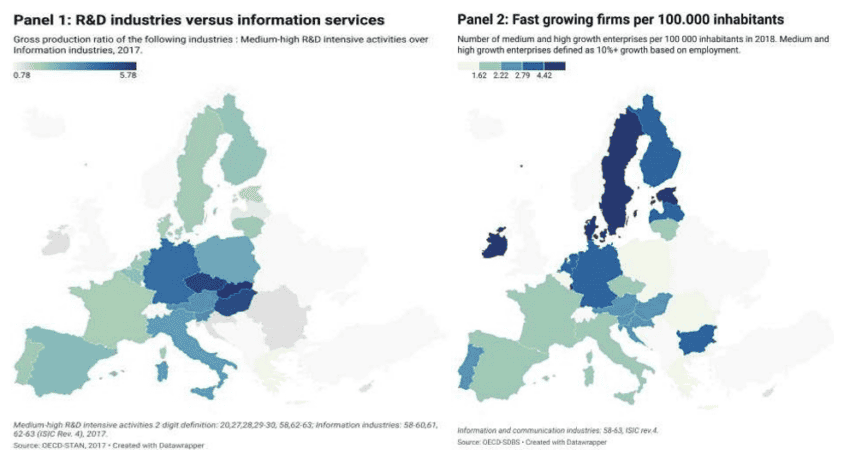Published
Boosting the Use of AI in Europe – Follow the Nordics?
By: Fredrik Erixon
Subjects: Digital Economy European Union

Different paradigms or mental models sometimes take hold of policymakers. In the field of AI, Europe has for the past years been beguiled by “regulation” – a model that is not just assumed to promote AI safety but also generate stronger economic benefits. Alongside regulation runs a supplementary paradigm that has captured the attention: “sovereignty”. There are aspects to both mental models that are useful, but it is far more important now for the EU to shift to a new paradigm. I call this model “diffusion” – using public policy to help spread AI opportunities and to get businesses, organisation, and people to use them. If Europe has a big AI challenge, this is it.
I talked about this at a recent conference on the Nordic Model in the Age of AI that we hosted alongside several companies and organisations a few weeks ago. And the Nordic example holds some lessons for the EU. If we take the broad data economy, there is a geographic pattern that should be observed. In stylised terms, these patterns can be described by two propositions on Europe’s economic geography that, obviously, hang together:
- The higher up you go on the EU map, the stronger the digital economic performance.
- The higher up you go on the EU map, the stronger the productivity performance.
The actual maps below confirm these observations. The four panels look at different aspects of the broad data economy. Panel 1 shows patterns of high value-added specialisation, basically if economies are specialising in the fields of R&D industry sectors or in broad R&D-based data services. The greener a country is coloured, the more it is geared towards high value-added data services. Panel 2 shows the intensity of fast-growing firms in countries – and the bluer a country is coloured, the greater its intensity of fast-growing firms. Panel 3 shows the intensity of data suppliers in a country – and, again, the bluer the colour, the more data suppliers the country has per capita. Finally, panel 4 looks at R&D intensity in data services. The bluer the country is coloured, the higher the R&D intensity.
Observant readers will already have noticed the pattern: even if there are some variations among the Nordic countries, they seem to perform high in all these panels and, as a group, they are different from other EU countries. AI adoption is also higher in the Nordics than in Western Europe. Denmark and Finland are at the top in the EU and compare well with global leaders in AI adoption. Sweden is somewhat behind but clearly ahead of the EU average. There are, of course, other EU countries that follow the Nordics in one or two of the panels. Few, however, show a consistent performance across all of them that points to an economy that is equally thriving on the back of digitalisation and new data technologies.

 The Nordic orientation towards a digital economy also helps to explain its productivity growth – and why it is higher in the Nordics than in the EU. The figure below shows GDP per hour worked between 1995 and 2023 in EU countries relative to the US. Denmark and Sweden have higher productivity than the US. Finland trails the Nordic EU peers but have kept their position relatively stable over the period – unlike most Western European countries that have experiences a pretty sharp decline vis-à-vis the US.
The Nordic orientation towards a digital economy also helps to explain its productivity growth – and why it is higher in the Nordics than in the EU. The figure below shows GDP per hour worked between 1995 and 2023 in EU countries relative to the US. Denmark and Sweden have higher productivity than the US. Finland trails the Nordic EU peers but have kept their position relatively stable over the period – unlike most Western European countries that have experiences a pretty sharp decline vis-à-vis the US.
Figure: GDP/hour worked relative to the US It is obviously not the size of the economy or the size of Nordic firms that have put them in this position. All Nordic economies are comparatively small and, apart from Novo Nordisk, they really don’t have big firms that can be put in the category of global “champions”. For small economies, it is not scale but intensity that is important – that they increase the intensity of production factors and adoption in those areas that set the tone for modern economic development. While they have regulation and care about sovereignty (or, to use a better term, capabilities), they have a policy which much more focused on promoting technology use and encouraging the type of economic change that boost tech-driven growth across sectors.
It is obviously not the size of the economy or the size of Nordic firms that have put them in this position. All Nordic economies are comparatively small and, apart from Novo Nordisk, they really don’t have big firms that can be put in the category of global “champions”. For small economies, it is not scale but intensity that is important – that they increase the intensity of production factors and adoption in those areas that set the tone for modern economic development. While they have regulation and care about sovereignty (or, to use a better term, capabilities), they have a policy which much more focused on promoting technology use and encouraging the type of economic change that boost tech-driven growth across sectors.
What are the overarching economic factors that have been important for the Nordic data orientation?
First, they have been more focused than others on adoption. They better follow the credo: the power of innovation lies in its adoption, not its creation!
Second, they cannot compete on scale – having big markets or many consumers – but they can be at the global frontier of technology and productivity by focusing on higher intensity in the use of modern technology.
Third, they have accepted greater market churn and not prioritised incumbent firms over new ones. Technological change is disproportionally driven by new companies that are breaking into markets or into sectors where they previously weren’t established. Countries that rather prefer to preserve incumbent firms or a market hierarchy perform less well in developing greater intensities.
Fourth, the Nordic countries are internationally oriented and practice market openness. They don’t cherish sovereignty concepts that imitate policies for closing markets and fending off competition.
Fifth, being small economies, the Nordics need to allow for greater specialisation – at all levels (human capital, business organisations, sectors, full economy).
Finally, they have proven better than others to collaborate around an idea. I think this is very important. Moving with technological change is really about moving with ideas and having models of cooperation in the economy where spur and adopt new ideas. This requires team formations and good markets that can facilitate coordination. It is also based on strong capital markets that increasingly play the role of moving and reallocating assets to get more output.